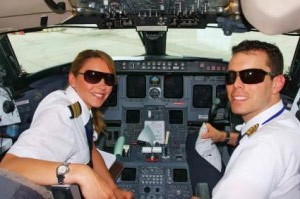
You must first complete your private pilot license before you can make the exciting next step to this qualification though if you haven’t already done this and your goal is to go all the way to commercial you can complete all the necessary qualifications, including your PPL (private license) with the same pilot training school in most cases.
The commercial pilot license is really the starting point of your commercial flight training. It has limited use and value on its own so to become employable to any degree and command a decent salary you will need to up-skill significantly gaining multiple extra ratings and upgrading your skills to Airline Transport Pilot (ATP).
Commercial Pilot Requirements
This is a brief summary of the requirements to gain your commercial license. There are various exceptions which we do not have the ability to cover in detail.
Minimum Eligibility Requirements:
- Proficiency in understanding, reading, writing and speaking the English language.
- Be at least 18 years old.
- Hold a private pilot license
- Meet the requirements for aeronautical experience relating to the class rating and aircraft category you are seeking.
- Complete and pass practical exam.
- Pass the knowledge/theory test.
Commercial Pilot Single Engine Airplane Rating
For this basic rating you must have logged a minimum of 250 hours flight time as pilot in command. Fifty of these (or a maximum of 100 hrs in accordance with FAA Part 142), may have been completed in an approved flight training device or flight simulator representing a single engine airplane) that consists of at least:
- 100 hours in powered aircraft, of which 50 hours must be in airplanes.
- 100 hours of pilot in command flight time, which includes at least 50 hours in airplanes and 50 hours in cross-country flight in airplanes.
- 20 hours of training on the areas of operation as listed for this rating, that includes at least 10 hours of instrument training, of which at least 5 hours must be in a single engine airplane, 10 hours of training in an airplane that has a retractable landing gear, flaps, and a controllable pitch propeller, or is turbine-powered, one cross- country flight of at least 2 hours in a single engine airplane in day VFR conditions, consisting of a total straight-line distance of more than 100 nautical miles from the original point of departure, one cross-country flight of at least 2 hours in a single engine airplane in night VFR conditions, consisting of a total straight-line distance of more than 100 nautical miles from the original point of departure.
- 10 hours of solo flight in a single engine airplane, including one cross-country flight of not less than 300 nautical miles total distance and as specified, and 5 hours in night VFR conditions with 10 takeoffs and 10 landings (with each landing involving a flight in the traffic pattern) at an airport with an operating control tower.
Medical Requirements – Commercial Pilot
The medical requirements for a commercial pilot depend on whether you will be performing airline duties or not. For non airline commercial pilot duties a Class 2 FAA Medical Certificate (in the United States) will suffice, while a pilot performing airline duties will require a Class 1 FAA Medical Certificate (in the United States). If you require an aviation medical certificate or more information about each class follow this link to a list of FAA Medical Examiners and other information about each class of medical. The medical requirements for a commercial pilot are rigorous and particularly for any pilot wishing to retain an Airline Transport Pilot Certificate (Class 1 Medical Certificate). These certificates are only valid for 12 months for pilots under the age of 40, and 6 months for pilots 40 years and over.
Read the following page for detailed information on commercial pilot medical requirements.
Training to Become a Commercial Pilot
Commercial Pilot Salary
Before you commit too much time and money to gaining your license it’s important to have some knowledge around your future potential earning power as a pilot. Is it worth the time and money commitment in the end?
Commercial pilot salaries vary greatly depending on a number of factors including, your skills and experience, type of plane you are flying, where you live and what company you work for. It is definitely possible to earn well over $100,000 though, in the right job. Our Pilot Salary page will give you more detailed information on your future earning potential.
Resources
Air Line Pilots Association, International http://www.alpa.org/
\